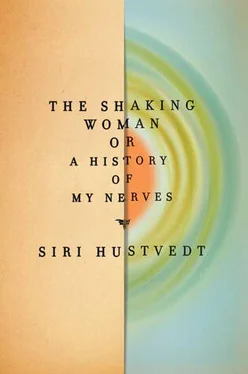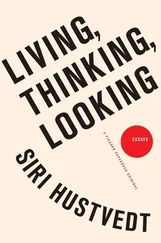Infants and most animals do not recognize themselves in mirrors. My dog Jack had no interest in his own reflection and had no idea that it belonged to him. At some moment in their development, human beings, some primates, elephants, and a species of dolphin are able to know they are looking not at others but at themselves. It is a privilege of the highly evolved. The psychoanalyst Jacques Lacan named this turn in human life the mirror stage ( stade de miroir ), identifying the moment when a child looks at her own reflection and sees herself as an externalized whole, as if she were gazing at herself through the eyes of another person. 46But most of the time we do not see ourselves whole. I see only parts of my body, my hands and part of my arm when I type, for example, or none of it when I stroll through the street taking in the sights and sounds and smells. In his essay “The Child’s Relation to Others,” Maurice Merleau-Ponty writes, “The consciousness I have of my own body is not the consciousness of an isolated mass; it is a postural schema [ schéma corporel ].” 47It is an introceptive sense, to borrow the philosopher’s vocabulary. Following Merleau-Ponty, Shaun Gallagher proposes making a distinction between body schema and body image . The former is “a system of sensory motor capacities,” 48a mostly unconscious system. When I reach for a glass, I don’t have to watch my arm reach for it or measure the distance between my hand and the glass; I do it without thinking.
My body image, on the other hand, is conscious — the beliefs and thoughts I have about my physical being. I’m fat or thin or ugly or beautiful; it is I as an object, a perception of my body from the outside, and I would suggest what Gallagher doesn’t dwell on, that an important part of that construction takes place linguistically. But there is a deeply emotional quality to self-recognition as well. Seeing the self has a particular affective resonance, and if that familiar feeling doesn’t happen, the reflection loses its meaning. S.M. had retained good operation of her body schema but could be said to have lost one aspect of her body image, the ability to say, That’s not another person, that’s myself standing there in the mirror. She, too, suffered a lapse in subjectivity, a failure of one aspect of her self-ownership — in this case, ownership of her reflection.
Human beings are binary creatures: two arms, two legs, two eyes, two ears, two nostrils, and two hemispheres of the brain that look alike, although the two sides are said to be dominant for different functions. They communicate with each other through the neural fibers that attach the two halves, the corpus callosum. In the 1960s, Roger Sperry began his experiments on patients who, due to intractable epileptic seizures, had undergone an operation called a commissurotomy: their corpus collosums had been severed. “Each disconnected hemisphere,” Sperry said in his Nobel Prize acceptance speech, “behaved as if it were not conscious of the cognitive events in the partner hemisphere. .. Each brain half, in other words, appeared to have its own, largely separate cognitive domain with its own private perceptual learning and memory experiences.” 49Are we two or one?
Among the stranger stories in neurology are those of people who appear to be torn in half. Their doubles take up residence in their own bodies, and their right and left sides do battle. When the right hand buttons up a shirt, the left hand unbuttons it. When the right hand opens a drawer, the left slams it shut. After their surgeries, some split-brain patients developed “strange” or “alien hand” syndrome. Dahlia Zaidel recorded some of their comments: “My left hand takes my cigarette out of my mouth while I’m smoking”; “I turn on the water with my right hand and the left turns it off.” 50People with a hand that rebels often berate the offending limb, crying out, “Bad hand!” or slapping it to restrain it from making further mischief. One man had to subdue a hand that had a marked tendency to creep up his thigh and head for his genitals, even when there were other people in the room. In 1908, the German neurologist Kurt Goldstein reported a case of a woman with a demon hand: “On one occasion, the hand grabbed her own neck and tried to throttle her and could only be pulled off by force.” 51After the woman’s death, the physician discovered multiple lesions in her brain, including one in the corpus callosum. None of these people would identify the impetuous, conniving hand as “I.” Indeed, in these cases, the offending limb seems to have an insurrectionist life of its own and is identified in the third person as outside the self, a force entirely opposed to the will of its owner. Usually, although not always, it’s the left hand that is delinquent. The motor functions of the left hand are controlled by the right hemisphere of the brain, just as the left hemisphere controls the right hand. The areas that control the “I,” the first-person subject who speaks, however, usually reside in the left hemisphere, in the language areas of the brain, the sites Freud discussed in his book on aphasia. In alien hand syndrome there is a well-functioning “I,” a law-abiding, thinking, speaking self that is conscious and has civilized intentions, and another thing or it that seems to be operating without permission.
I am the one who hears. It is I who feels and thinks and sees and speaks. This is where I begin and where I end. I identify myself in the mirror. I see you. You are looking at me. This is my narrating self, my conscious, telling self. But it is not the shaking self, nor the flashback self. Mark Solms and Oliver Turnbull cite one of Sperry’s experiments on a split-brain patient in their book The Brain and the Inner World . An image is briefly flashed on a screen. In such patients, the right hemisphere will perceive the image, but it won’t be accessible to the left. A woman was shown pornographic pictures. She giggled but couldn’t explain her reaction. “This case,” the authors write, “demonstrates that an entire cerebral hemisphere can process information unconsciously.” More importantly, they argue, “For someone to reflect consciously on visual experience, he or she has to recode the visual experiences into words.” 52Language appears to be vital to self-reflexive awareness, the ability to say, I saw sexy pictures on the screen that embarrassed and titillated me, but it is not necessary for registering the images and responding to them. Versions of this right/left brain division have led to popular but simplistic notions of right-and left-brain personalities and other reductive speculations, such as attributing consciousness to the left hemisphere and unconsciousness to the right. Sperry and others have shown that the right brain isn’t entirely aphasic or nonverbal, although it is regarded as dominant for spatial and imagistic functions.
Some patients who can’t say why they feel shocked, amused, or frightened by an unconscious perception confabulate . S.M. saw her reflection, didn’t recognize it, couldn’t feel it was herself, and so she confabulated another S.M. Confabulation isn’t lying; the neurological term refers to the explanations brain-damaged people come up with to explain the mysteries that confront them. When the right hemisphere takes in a picture and the information isn’t sent to the left, the verbal neocortex will do its best to explain what’s going on. Michael Gazzaniga, who worked with split-brain patients, called this “the left brain interpreter.” 53Those of us with intact corpus callosums have more fluid correspondence between the hemispheres of our brain, but we, too, interpret the mysteries of various stimuli, internal or external, that come our way. The shaking woman is not the narrating woman. The narrating, interpreting woman continued on while the other shook. The narrator was a fluent generator of sentences and explanations. It is she who is writing now. I confess that in my gloomier moments I have wondered if a whole host of intellectual theories don’t fall into the category of grand confabulations.
Читать дальше












